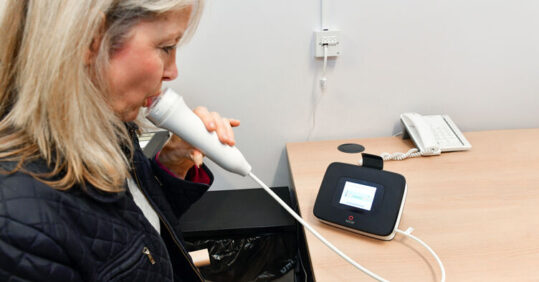Advanced nurse practitioner and asthma lead Beverley Bostock explains how fractional exhaled nitric oxide (FeNO) testing works and its place in supporting asthma diagnosis and management
The latest Global Initiative for Asthma (GINA) report,1 published this year, highlighted that asthma is a heterogeneous condition, usually caused by chronic airway inflammation.
In recent years, there has been greater recognition of the fact that asthma can present in a variety of ways and with different endotypes (physiological pathways) driving the phenotype (how the asthma ‘behaves’).
This article explores these differences with a focus on how biomarkers, and specifically fractional exhaled nitric oxide (FeNO) testing can support the diagnosis and management of asthma.
By the end of the full module the reader should be able to:
- Recognise the key drivers of asthma phenotypes.
- Understand the role of history taking and objective tests in the diagnosis of asthma.
- Consider how FeNO testing can be used to support the diagnostic process.
- Interpret FeNO results in context.
- Consider the use of FeNO in the ongoing management of asthma.
Asthma phenotypes
Currently asthma is divided into two main groups, namely Type 2 (T2) inflammation asthma, or ‘T2-high’ asthma, and non-T2, or ‘T2-low’ asthma, with roughly 50% of patients belonging to one of the two groups.2
The T2-high asthma phenotype is characterised by eosinophilic infiltration of the airways and raised nitric oxide (NO) levels. The latter can be detected in exhaled breath.
By contrast, T2-low asthma is characterised by airway remodelling and neutrophil activity, rather than eosinophilic inflammation.3 T2-low asthma is more common in women, people with a history of smoking and people living with obesity.4
T2-high asthma and T2-low asthma also respond differently to asthma treatment: inhaled corticosteroid (ICS) therapies are effective in T2-high asthma, but elicit a poor response in people with T2-low asthma.2
Thus measuring the level of fractional exhaled NO (FeNO) in patients’ breath can help identify eosinophilic inflammation in the airways and guide the diagnosis and management.
Recommended use of FeNO
According to British Thoracic Society (BTS) and the Scottish Intercollegiate Guidelines Network (SIGN) joint guidelines, the diagnosis of asthma relies on effective history taking, along with the use of objective tests to confirm the presence of reversible airflow obstruction.5 Typical symptoms include cough, wheeze, tight chest and shortness of breath, with variability in symptoms and airflow obstruction. The individual will often recognise triggers that set off or exacerbate the symptoms, such as exercise, viruses, changes in air temperature or quality, or allergens such as dust mites and pollens.
Objective tests can provide evidence of the presence of airflow obstruction, reversibility and airway inflammation. Spirometry is considered to be the gold standard test for airflow obstruction, and reversibility testing can underpin a diagnosis of asthma if there is a return to normal or near normal lung function post-bronchodilator, with an increase in the forced expiratory volume in 1 second (FEV1) of at least 12% and increase in volume of 200ml regarded as a positive test for asthma in adults.5 Home peak expiratory flow rate (PEFR) readings can be used to identify abnormal and variable lung function and to assess response to treatment.
FeNO testing offers a different perspective by indicating the presence of eosinophilic inflammation, which can be useful both as a confirmatory test and also as an additional test to detect asthma when spirometry is normal (as it may be on any given day, as a result of the variable nature of asthma).
Author
Beverley Bostock is an Advanced Nurse Practitioner, PCN Nurse Coordinator Hereford and Asthma Lead, Association of Respiratory Nurse Specialists.
Find this module
The full CPD module can be found on the Nursing in Practice 365 website.
Not a Nursing in Practice 365 subscriber? Register for free or gain access to more CPD content as a Premium member.







